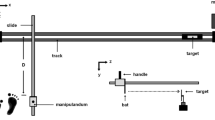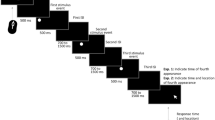Abstract
This investigation aimed at assessing the extent to which memory from practice in a specific condition of target displacement modulates temporal errors and movement timing of interceptive movements. We compared two groups practicing with certainty of future target velocity either in unchanged target velocity or in target velocity decrease. Following practice, both experimental groups were probed in the situations of unchanged target velocity and target velocity decrease either under the context of certainty or uncertainty about target velocity. Results from practice showed similar improvement of temporal accuracy between groups, revealing that target velocity decrease did not disturb temporal movement organization when fully predictable. Analysis of temporal errors in the probing trials indicated that both groups had higher timing accuracy in velocity decrease in comparison with unchanged velocity. Effect of practice was detected by increased temporal accuracy of the velocity decrease group in situations of decreased velocity; a trend consistent with the expected effect of practice was observed for temporal errors in the unchanged velocity group and in movement initiation at a descriptive level. An additional point of theoretical interest was the fast adaptation in both groups to a target velocity pattern different from that practiced. These points are discussed under the perspective of integration of vision and motor control by means of an internal forward model of external motion.




Similar content being viewed by others
Notes
Temporal absolute error was selected for analysis of temporal accuracy based on the rationale presented by (Spray 1986).
As the software generated real random sequences of velocity conditions, there were somewhat distinct numbers of trials in unchanged and decreased velocity under the uncertainty context. This characteristic prevented analysis of the whole set of 20 probing trials.
References
Barrett NC, Glencross DJ (1989) Response amendments during manual aiming movements to double-step targets. Acta Psychol (Amst) 70:205–217
Brouwer AM, Brenner E, Smeets JB (2002) Hitting moving objects: is target speed used in guiding the hand? Exp Brain Res 143:198–211
Brouwer AM, Middelburg T, Smeets JB, Brenner E (2003) Hitting moving targets: a dissociation between the use of the target’s speed and direction of motion. Exp Brain Res 152:368–375
Brouwer AM, Smeets JB, Brenner E (2005) Hitting moving targets: effects of target speed and dimensions on movement time. Exp Brain Res 165:28–36
Cerminara NL, Apps R, Marple-Horvat DE (2009) An internal model of a moving visual target in the lateral cerebellum. J Physiol 587:429–442
Coull JT, Vidal F, Goulon C, Nazarian B, Craig C (2008) Using time-to-contact information to assess potential collision modulates both visual and temporal prediction networks. Front Hum Neurosci 2:1–10
de Azevedo Neto RM, Teixeira LA (2009) Control of interceptive actions is based on expectancy of time to target arrival. Exp Brain Res 199:135–143
de Lussanet MH, Smeets JB, Brenner E (2001) The effect of expectations on hitting moving targets: influence of the preceding target’s speed. Exp Brain Res 137:246–248
de Lussanet MH, Smeets JB, Brenner E (2004) The quantitative use of velocity information in fast interception. Exp Brain Res 157:181–196
Gray R (2002a) Behavior of college baseball players in a virtual batting task. J Exp Psychol Hum Percept Perform 28:1131–1148
Gray R (2002b) “Markov at the bat”: a model of cognitive processing in baseball batters. Psychol Sci 13:542–547
Indovina I, Maffei V, Bosco G, Zago M, Macaluso E, Lacquaniti F (2005) Representation of visual gravitational motion in the human vestibular cortex. Science 308:416–419
Lacquaniti F, Carrozzo M, Borghese N (1993) The role of vision in tuning anticipatory motor responses of the limbs. In: Berthoz A (ed) Multisensory control of movement. Oxford, New York, pp 379–393
Le Runigo C, Benguigui N, Bardy BG (2005) Perception-action coupling and expertise in interceptive actions. Hum Mov Sci 24:429–445
Marinovic W, Plooy AM, Tresilian JR (2009) Preparation and inhibition of interceptive actions. Exp Brain Res 197:311–319
Marinovic W, Plooy AM, Tresilian JR (2010) The effect of priming on interceptive actions. Acta Psychol (Amst) 135:30–37
McIntyre J, Zago M, Berthoz A, Lacquaniti F (2001) Does the brain model Newton’s laws? Nat Neurosci 4:693–694
Senot P, Zago M, Lacquaniti F, McIntyre J (2005) Anticipating the effects of gravity when intercepting moving objects: differentiating up and down based on nonvisual cues. J Neurophysiol 94:4471–4480
Spray JA (1986) Absolute error revisited: an accuracy indicator in disguise. J Mot Behav 18:225–238
Teixeira LA, Lima ES, Franzoni MM (2005) The continuous nature of timing reprogramming in an interceptive task. J Sports Sci 23:943–950
Teixeira LA, Chua R, Nagelkerke P, Franks IM (2006a) Reprogramming of interceptive actions: time course of temporal corrections for unexpected target velocity change. J Mot Behav 38:467–477
Teixeira LA, Chua R, Nagelkerke P, Franks IM (2006b) Use of visual information in the correction of interceptive actions. Exp Brain Res 175:758–763
Teixeira LA, Franzoni MM, da Silva JB (2006c) Are the elderly able to appropriately reprogram their actions? Mot Control 10:93–108
Tijtgat P, Bennett SJ, Savelsbergh GJ, De Clercq D, Lenoir M (2010) Advance knowledge effects on kinematics of one-handed catching. Exp Brain Res 201:875–884
Tresilian JR (2005) Hitting a moving target: perception and action in the timing of rapid interceptions. Percept Psychophys 67:129–149
Zago M, Lacquaniti F (2005) Internal model of gravity for hand interception: parametric adaptation to zero-gravity visual targets on Earth. J Neurophysiol 94:1346–1357
Zago M, Bosco G, Maffei V, Iosa M, Ivanenko YP, Lacquaniti F (2004) Internal models of target motion: expected dynamics overrides measured kinematics in timing manual interceptions. J Neurophysiol 91:1620–1634
Zago M, Bosco G, Maffei V, Iosa M, Ivanenko YP, Lacquaniti F (2005) Fast adaptation of the internal model of gravity for manual interceptions: evidence for event-dependent learning. J Neurophysiol 93:1055–1068
Zago M, McIntyre J, Senot P, Lacquaniti F (2009) Visuo-motor coordination and internal models for object interception. Exp Brain Res 192:571–604
Zago M, Iosa M, Maffei V, Lacquaniti F (2010) Extrapolation of vertical target motion through a brief visual occlusion. Exp Brain Res 201:365–384
Acknowledgments
This work was supported with a studentship granted to the first author (FAPESP, Brazil, #2006/05336-3) and a scholarship granted to the second author (CNPq, Brazil, #308312/2006-6). The authors are grateful to Leandro Caminha for assistance in data analysis, to Marcos Duarte for making available the camera used in this study, and to Ana Claudio for the artwork of Figure 2.
Author information
Authors and Affiliations
Corresponding author
Rights and permissions
About this article
Cite this article
de Azevedo Neto, R.M., Teixeira, L.A. Intercepting moving targets: does memory from practice in a specific condition of target displacement affect movement timing?. Exp Brain Res 211, 109–117 (2011). https://doi.org/10.1007/s00221-011-2657-4
Received:
Accepted:
Published:
Issue Date:
DOI: https://doi.org/10.1007/s00221-011-2657-4




